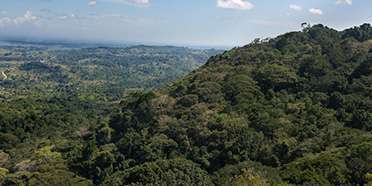A good one-day safari if you are on the coast
This is a good mini-safari for anyone who is staying on the Kenya coast, especially the South Coast. However, I would not recommend traveling to the coast just to visit this reserve. If you are in Nairobi, you have better options within 3-4 hours of the capital.
What is so nice about Shimba Hills? It is a lovely patch of forested hills only 30 minutes' drive from the beach hotels. That means you can spend the day viewing animals in an authentic African setting, and still squeeze in a sunset swim on the beach before dinner.
It is also a pocket-friendly safari, at least by today's standards. The reserve's low entrance fee allows the tour operators to keep the cost of a full-day safari to around US$100, and that includes a gourmet lunch at Shimba Hills Lodge (drinks extra).
On to the animals: You should be aware that this reserve does not host lions or cheetahs, and there are no rhinos. So you will not see all of the "big five" species here. The occasional cat may sneak in, but they are officially banned because of the presence of the sable antelope, a majestic, large antelope with a purple-ish hide that is exclusive to this reserve. Come to Shimba Hills, and you can boast that you have been to the last refuge of this species.
Elephants are quite numerous both inside and outside the reserve, so numerous that the Kenya Wildlife Service has had to remove some of them in the past, driving them to Tsavo West National Park a hundred km away. However, because of the plentiful forest in Shimba Hills, spotting them is not guaranteed. I have seen at least one on every visit, but I have met people who did not. The elephants love the shade and tasty fruits on offer in the forest, and they come from far and wide for this perk. You could pass very close to an elephant loitering in a forest without even knowing.
There is a small giraffe population, but they are easier to spot as they tend to stay in the more open savannah near the main gate. They are of the Maasai sub-species, and I was told they had been imported from Amboseli National Park. But since this is an authentic ecosystem and not a zoo, that fact didn't seem to detract from the safari experience. Transportation of animals between parks is not uncommon these days.
Buffalo are another attraction here. Their still, lump-like forms, usually seen from far away, don't stimulate me as much as an elephant with its complex personality. There are probably a handful of buffalo herds in Shimba Hills, and their tendency to stick to large, open fields means you will definitely see them on your visit.
There are many warthogs! Normally pathologically shy, these beasts graze in large groups just a few metres from your vehicle. I have heard a few people comment that they had never seen so many warthogs in one place. The exceptionally lush grass may have something to do with this.
Of the other hoofed animals, I liked the sable antelopes if only for the fact that they are extremely rare. Huge bush bucks, almost the size of moose, make a tremendous noise when they smash through the forest after being surprised. The other well-known gazelles and antelopes are also found here in good numbers. I have, however, seen so many Thompson's gazelles around Kenya that my eyes seem to pass right over them.
It should be noted that the safari drivers will make every effort to ensure that you see the animals you want to see. They are radio-dispatched, and if elephants are scarce, for example, they will call other drivers to try to locate them for you. But as in any other park, there is no money-back guarantee!
The roads in Shimba Hills Reserve are well maintained and are passable in any weather. You can enter with your own two-wheel drive car if you wish, as long as it is in good condition and the KWS staff don't think it will have to be towed back out. Drivers cannot leave the roads to go cross-country. The road network is so good, in fact, that it gives the reserve a slightly artificial feel, akin to the "safari parks" in the UK with their excessive signposting. That is the only reason I don't give Shimba Hills 5 stars for "bush vibe". But it does make a do-it-yourself game drive a breeze.
Feel like swimming in a waterfall? Shimba Hills is one of just a few parks in Kenya where you can peel off and bathe in a pool under a crystal-clear waterfall, with no need to worry about crocodiles or hippos! To visit Sheldrick's Falls (named after the conservationist David Sheldrick) you must be prepared to walk for 45 minutes in fairly hot, humid weather, so bring a large water bottle. But the idyllic 15-metre waterfall, surrounded by lush forest, is well worth the effort. The escorted walk is offered with every day-safari, normally after the morning game drive and before lunch.
As mentioned above, the midday meal is served at Shimba Hills Lodge, which is also inside the reserve. It is a treehouse-style lodge - actually resting on piles, but with several large trees growing right through the middle. No one could say that it is not a very enchanting place, at least to eat. The dining tables are arranged on a covered veranda that overlooks a small pond and the forest beyond. This is not a Tsavo-style waterhole that attracts elephants, lions and other large animals. Here you may see gazelles sneaking a drink, and you can always watch the resident hawks swoop down to pick up balls of ugali (Kenyan maize cake) thrown by the waiters. There is also a large monitor lizard living right under the lodge amid the supports!
Aside from a few rarely-used campsites in the reserve, Shimba Hills Lodge is the only tourist-quality accommodation in or near the reserve. For details and reviews of the hotel rooms, it is best to consult Tripadvisor or similar sites.
Shimba Hills Reserve is not Africa's greatest wildlife park. But its convenience, coupled with a few unique charms such as the waterfall, have made it my "local" when it comes to safaris. Offering a real African bush experience a stone's throw from the beach, it waits there for me whenever I crave a change. I have not yet tired of it.

![1-Day Shimba Hills Adventure]()

![12-Day Vacation Escape to Kenya Coast]()


 Kenya Parks
Kenya Parks





